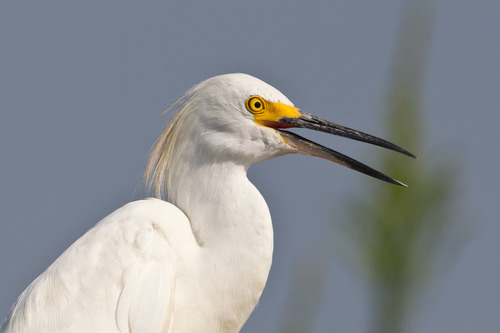
Snowy Egret
The Snowy Egret (Egretta thula) is a small, elegant heron characterized by its slender black bill, black legs, and vibrant yellow feet. It's a highly adaptable wading bird found across a wide range of wetland habitats in the Americas. The Snowy Egret plays a crucial role in wetland ecosystems, helping to control populations of fish and invertebrates. Historically, this species was heavily hunted for its beautiful plumes, leading to significant population declines in the late 19th and early 20th centuries. However, conservation efforts have allowed it to recover remarkably.
55-66 cm
Length
95-112 cm
Wingspan
Least Concern
Conservation Status
Distribution
The Snowy Egret is found throughout North, Central, and South America. Its range extends from the northern United States south to Argentina and Chile. It is a migratory species, with northern populations moving south for the winter. They can be found at various altitudes, from sea level to higher elevations in some regions.
Lifespan
The average lifespan in the wild is not well-documented, but some individuals have been known to live over 10 years. Captive birds may live longer.
Snowy Egret's Habitat
Habitat Types
Coastal marshes, Saltwater and freshwater wetlands, Mangrove swamps, Lakes, Rivers, Flooded agricultural fields
Climate Zones
Temperate, Subtropical, Tropical
Adaptations
The Snowy Egret's long legs and toes are adapted for wading in shallow water, allowing it to stalk prey effectively. The yellow feet are thought to be used to lure or stir up prey in the water. Its sharp bill is perfect for spearing fish and other small aquatic animals.
Variations
Two subspecies are generally recognized: *E. t. thula* (found in most of the range) and *E. t. brewsteri* (found in western North America, with slightly larger size and thicker bill).
Appearance
Breeding Plumage
During the breeding season, adults develop long, delicate plumes (aigrettes) on their back, head, and breast. Outside of the breeding season, these plumes are absent or greatly reduced.
Seasonal Feather Changes
The most significant seasonal variation is the presence or absence of breeding plumes. The color of the soft parts (bill, legs, and feet) may also become more intense during breeding.
Sex Based Plumage Differences
There is minimal sexual dimorphism in plumage, with both males and females developing similar breeding plumes.
Notable Features
Slender black bill, Black legs, Bright yellow feet, Long, delicate plumes during breeding season
Diet and Feeding
Primary Foods
Small fish, Crustaceans, Insects, Amphibians, Reptiles, Worms
Foraging Behavior
Snowy Egrets are active foragers, employing a variety of techniques. They may stand still and wait for prey, walk slowly and stalk, or actively run and chase prey in shallow water. They often use their feet to stir up the bottom or to flush out hidden prey.
Specializations
Their slender, sharp bill is perfectly adapted for spearing fish and other small animals. Their long legs and neck allow them to reach prey in deeper water than some other small wading birds.
Seasonal Diet Variations
Diet can vary depending on prey availability. For example, during times when fish are less abundant, they may consume more insects or crustaceans.
Behavior
Social Structure
Snowy Egrets are often found in mixed-species flocks, especially during foraging. They are colonial nesters, often forming large breeding colonies with other heron species.
Communication
Vocalizations include croaks, squawks, and calls., Visual displays, such as raising plumes and stretching necks, are used in courtship and territorial defense.
Migration
Northern populations are migratory, moving south to warmer climates for the winter. Southern populations may be resident or only make short-distance movements.
Territorial or Group Behaviors
During the breeding season, Snowy Egrets defend small territories around their nests. Outside of the breeding season, they are generally more social and may forage in large groups.
Conservation
Threats
Habitat loss and degradation (wetland drainage and pollution), Climate change (sea-level rise, altered precipitation patterns), Human disturbance (at nesting colonies), Past hunting for plumes (historically significant)
Protection Programs
Migratory Bird Treaty Act (in the United States), Wetland conservation and restoration initiatives, CITES Appendix II (regulates international trade)
Local National Laws
Protected under various state and national laws in many countries throughout its range.
Population Trend
Increasing
Population Estimates
The global population is estimated to be in the hundreds of thousands, and is considered stable or increasing in many areas.
Interesting Facts
Snowy Egrets were once hunted nearly to extinction for their plumes.
In the late 19th and early 20th centuries, their plumes were highly valued in the millinery trade for decorating women's hats.
They sometimes use a 'foot-stirring' technique to hunt.
They shuffle their bright yellow feet in the water to disturb prey and make them easier to catch.
They often nest in mixed-species colonies.
This provides some protection from predators, as there are more eyes to watch for danger.
Faqs about Snowy Egret
What is the difference between a Snowy Egret and a Great Egret?
Snowy Egrets are smaller than Great Egrets and have black legs and yellow feet, while Great Egrets have yellow bills and black legs and feet.
Are Snowy Egrets endangered?
No, Snowy Egrets are currently listed as Least Concern by the IUCN. Their populations have recovered significantly since the early 20th century.
Where can I see Snowy Egrets?
Snowy Egrets can be found in a variety of wetland habitats throughout the Americas, including coastal marshes, swamps, lakes, and rivers. Look for them wading in shallow water.
Do Snowy Egrets mate for life?
Snowy Egrets are typically monogamous during a single breeding season, but mate fidelity across multiple years is not well-documented.
Copyright @ Nature Style Limited. All Rights Reserved.
 English
English